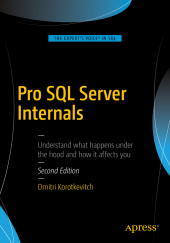 Neuerscheinungen 2016Stand: 2020-02-01 |
Schnellsuche
ISBN/Stichwort/Autor
|
Herderstraße 10
10625 Berlin
Tel.: 030 315 714 16
Fax 030 315 714 14
info@buchspektrum.de |

Dmitri Korotkevitch
Pro SQL Server Internals
2. Aufl. 2016. xxxi, 804 S. 138 SW-Abb., 353 Farbabb. 254 mm
Verlag/Jahr: SPRINGER, BERLIN; APRESS 2016
ISBN: 1-484-21963-5 (1484219635)
Neue ISBN: 978-1-484-21963-8 (9781484219638)
Preis und Lieferzeit: Bitte klicken
Improve your ability to develop, manage, and troubleshoot SQL Server solutions by learning how different components work "under the hood," and how they communicate with each other. The detailed knowledge helps in implementing and maintaining high-throughput databases critical to your business and its customers. You´ll learn how to identify the root cause of each problem and understand how different design and implementation decisions affect performance of your systems.
New in this second edition is coverage of SQL Server 2016 Internals, including In-Memory OLTP, columnstore enhancements, Operational Analytics support, Query Store, JSON, temporal tables, stretch databases, security features, and other improvements in the new SQL Server version. The knowledge also can be applied to Microsoft Azure SQL Databases that share the same code with SQL Server 2016.
Pro SQL Server Internals is a book for developers and database administrators, and it covers multiple SQL Server versions starting with SQL Server 2005 and going all the way up to the recently released SQL Server 2016. The book provides a solid road map for understanding the depth and power of the SQL Server database server and teaches how to get the most from the platform and keep your databases running at the level needed to support your business. The book:
- Provides detailed knowledge of new SQL Server 2016 features and enhancements
- Includes revamped coverage of columnstore indexes and In-Memory OLTP
- Covers indexing and transaction strategies
- Shows how various database objects and technologies are implemented internally, and when they should or should not be used
- Demonstrates how SQL Server executes queries and works with data and transaction log
What You Will Learn
Design and develop database solutions with SQL Server.
Troubleshoot design, concurrency, and performance issues.
Choose the right database objects and technologies for the job.
Reduce costs and improve availability and manageability.
Design disaster recovery and high-availability strategies.
Improve performance of OLTP and data warehouse systems through in-memory OLTP and Columnstore indexes.
Who This Book Is For
Developers and database administrators who want to design, develop, and maintain systems in a way that gets the most from SQL Server. This book is an excellent choice for people who prefer to understand and fix the root cause of a problem rather than applying a ´band aid´ to it.
Part 1: Tables and Indexes
1. Data Storage Internals
2. Tables and Indexes
3. Statistics
4. Special Indexing and Storage Features
5. SQL Server 2016 Enhancements
6. Index Fragmentation
7. Designing and Tuning the Indexes
Part 2: Other Things That Matter
8. Constraints
9. Triggers
10. Views
11. Functions
12. XML and JSON
13. Temporary Tables and TempDB
14. CLR
15. CLR Types
16. Data Partitioning
Part 3: Locking, Blocking, and Concurrency
17. Lock Types and Transaction Isolation Levels
18. Troubleshooting Blocking Issues
19. Deadlocks
20. Lock Escalations
21. Optimistic Isolation Levels
22. Application Locks
23. Schema Locks
24. Designing Transaction Strategies
Part 4: Query Life Cycle
25. Query Optimization and Execution
26. Plan Caching
Part 5: Practical Troubleshooting
27. System Troubleshooting
28. Extended events
29. Query Store
Part 6: Inside the Transaction Log
30. Transaction Log Internals
31. Backup and Restore
32. High Availability Technologies
Part 7: In-Memory OLTP Engine
33. Column-Based Storage and Batch Mode Execution
34. Columnstore Indexes
Part 8: In-Memory OLTP Engine
35. In-Memory OLTP Internals
36. Transaction Processing in In-Memory OLTP
37. In-Memory OLTP Programmability


